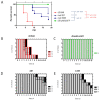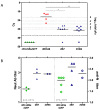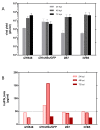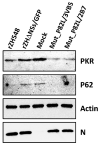The Change P82L in the Rift Valley Fever Virus NSs Protein Confers Attenuation in Mice
- PMID: 33805122
- PMCID: PMC8064099
- DOI: 10.3390/v13040542
The Change P82L in the Rift Valley Fever Virus NSs Protein Confers Attenuation in Mice
Abstract
Rift Valley fever virus (RVFV) is a mosquito-borne bunyavirus that causes an important disease in ruminants, with great economic losses. The infection can be also transmitted to humans; therefore, it is considered a major threat to both human and animal health. In a previous work, we described a novel RVFV variant selected in cell culture in the presence of the antiviral agent favipiravir that was highly attenuated in vivo. This variant displayed 24 amino acid substitutions in different viral proteins when compared to its parental viral strain, two of them located in the NSs protein that is known to be the major virulence factor of RVFV. By means of a reverse genetics system, in this work we have analyzed the effect that one of these substitutions, P82L, has in viral attenuation in vivo. Rescued viruses carrying this single amino acid change were clearly attenuated in BALB/c mice while their growth in an interferon (IFN)-competent cell line as well as the production of interferon beta (IFN-β) did not seem to be affected. However, the pattern of nuclear NSs accumulation was modified in cells infected with the mutant viruses. These results highlight the key role of the NSs protein in the modulation of viral infectivity.
Keywords: PXXP motifs; Rift Valley fever virus; interferon antagonist; non-structural NSs protein; nuclear filaments.
Conflict of interest statement
The authors declare no conflict of interest.
Figures





References
Publication types
MeSH terms
Substances
LinkOut - more resources
Full Text Sources
Other Literature Sources

